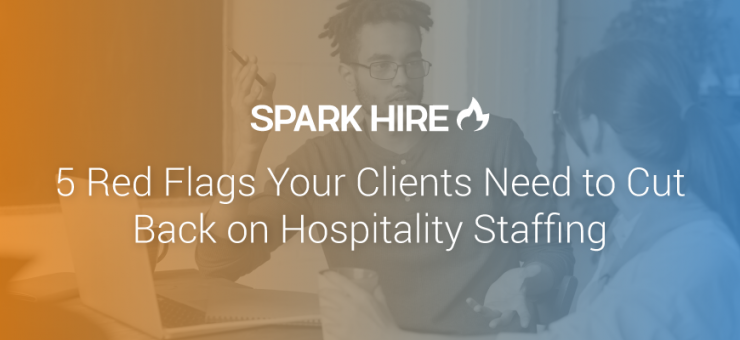There are about 20,000 staffing and recruiting firms in the U.S., according to the American Staffing Association’s latest trends analysis. This means there are a lot of other firms out there competing for clients. To say the pressure is on for you to fill roles is an understatement.
The weight of filling roles is especially burdensome when you’re staffing for the highly-demanding hospitality industry. It’s easy to get entangled in the placement process. But remember, your duty isn’t only to fill roles, it’s to fulfill the needs of both job seekers and clients.
With the hospitality industry’s unpredictability, you must take a step back to assess clients’ needs, including redundant roles they don’t currently have to fill. However, before you can determine their overall needs, you need to understand the warning signs of overstaffing.
Here are five red flags your clients should cut back on hospitality staffing for roles you no longer need to fill:
1. Their turnover is higher than ever
The hospitality industry is full of temporary employees. Their reasons for wanting this type of flexible work varies, of course. However, more than half of temporary workers (58%) in a 2019 Staffing Industry report said their primary reason for accepting temporary work was to use it as a method to find a regular/permanent job or because they thought it might lead to a regular/permanent position.
Even regular part-time employees may have the same goal of moving into a full-time role or being promoted. So, when they see complications arise, such as their roles becoming less necessary or their hours cut, they’re more likely to leave and find employment with a more secure future.
A decrease in employee satisfaction is another result of overstaffing that leads to increased turnover. When a client is overstaffed in a specific area, employees have to seek out unrelated tasks, or even busy work, to perform while on the clock and are often sent home early. This makes them wonder if they’re really needed or appreciated by your client.
And when employees feel they don’t belong, they’re less likely to remain loyal to an organization. In fact, “The Value of Belonging at Work,” a study from BetterUp, revealed a strong sense of belonging decreases turnover risk by 50%.
2. They have more employees than the industry average
As you know, hospitality staffing demands are unpredictable. One month business could be booming, and the next it comes to a stifling halt. Some of your clients are more aware of their current needs than others. And those needs evolve quickly with the fluctuation of demand and your clients immediately decrease their reqs when necessary.
Other clients, however, are less aware. Their focus remains heavily in areas of their business outside of staffing. This is a high compliment to your efforts, as they trust your ability to bring them consistent, quality talent. But as a result, they keep their staffing numbers the same or continue increasing their reqs. This happens even though others are making room for a natural decrease.
Clients who have a significantly higher staffing rate than the average of others in the same industry raise a red flag. They require a more in-depth analysis to determine why they’re staffing at such an increased rate, specifically for roles others recently put on hold.
3. The staffing ebb and flow has stopped
Hospitality staffing always comes with busy seasons. Whether they’re long or short, you know it’s critical to plan for an increase in placement demands.
When the ebb and flow of seasonal staffing needs stops, it’s likely a result of constant overstaffing. Your clients shouldn’t be meeting the demands of the regular season with a busy season’s worth of employees.
4. They’re failing to meet predictive scheduling requirements
Predictive scheduling laws are popping up in many states and localities, which are placing even greater importance on not overstaffing. New York City retailers, for example, must provide a written schedule at least 72 hours before the first shift of the schedule, according to Lexology. Other cities, such as Chicago, Illinois, and Philadelphia, enacted predictive-scheduling ordinances that will go into effect this year.
When clients fail to meet predictive scheduling laws or regularly reduce schedules a week in advance, it’s a definite red flag they’re overstaffed. Even if they’re part of a state or city without set predictive schedule laws, operating in this manner causes high employee turnover and negatively impacts their employer brand.
5. Their metrics are declining
When you see a pattern in dropping metrics, your clients may already be in a downward cycle due to overstaffing. For example, if turnover rates, employee satisfaction, performance, and other key metrics are declining year-round, there’s likely an issue in the staffing department.
Look for trends in declining metrics to identify the issue. A key bottom-line indicator is if your hospitality client is paying out more in temporary staff salaries than they bring in during a peak busy season.












